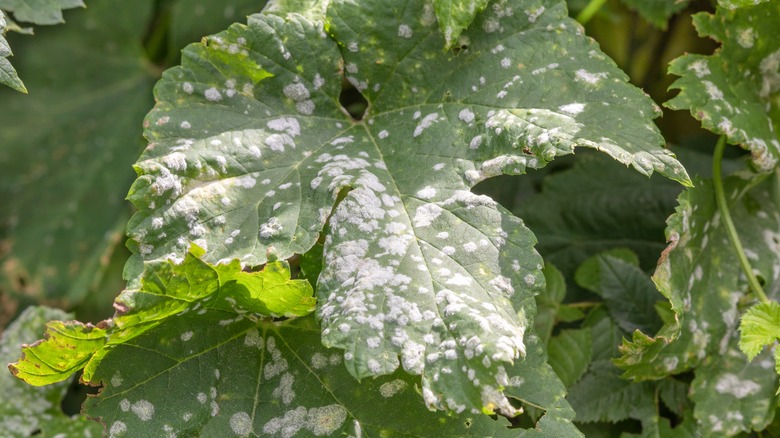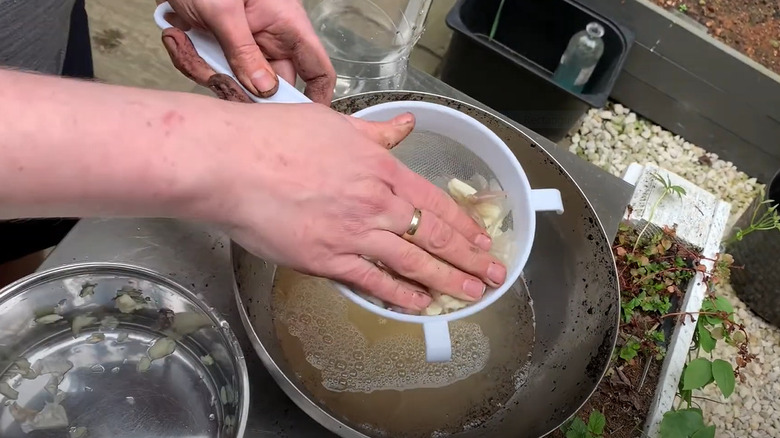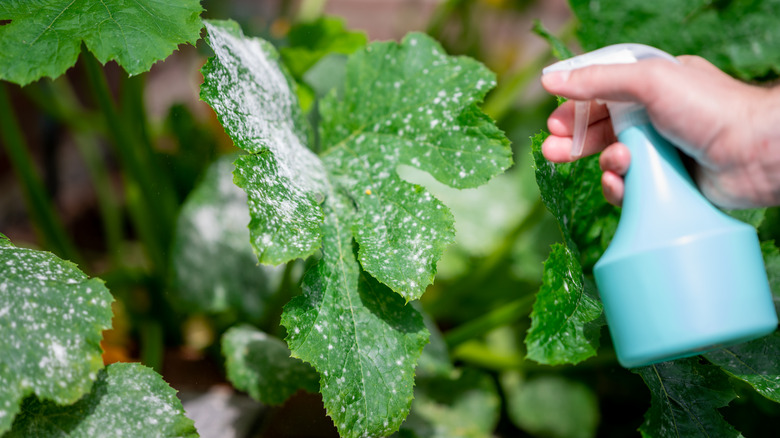Head To The Kitchen For A Savory Staple To Treat Fungus In The Garden
Isn't the dance between plants and fungus as old as life itself? Fungus in the garden appears in various guises, ranging from fuzzy white patches to black sooty mold, and their path of destruction is reflected in wilted leaves and stunted growth. Before these silent destroyers turn your blooming jungle into a barren wasteland, you can launch a surprise attack with a natural alternative to the harsh, potentially harmful chemical fungicides. Laying casual claim to a corner in your kitchen, our organic fungi-busting hero here is none other than garlic.
Deep within garlic's aromatic cloves exists a cocktail of phenolics like gallic acid, apigenin, tannic acid, catechin, and isoquercetin, which react vigorously when they come into contact with fungi. One study by the Kasetsart University and Development Insititute found out that an 80% concentration of garlic extract completely halted the growth of the notorious pathogenic fungi Phomopsi spp., notably surpassing its peers — chili or shallot extracts.
Want more regarding the intriguing tale of garlic's fungus-fighting abilities? Allicin, an organosulphur compound behind garlic's defining taste and odor, is also credited in the science arena for its powerful antifungal properties (per Frontiers in Plant Science). The beauty of using garlic water to treat fungi in your garden is that not only does it put to good use commonly found kitchen items, but it also advocates an eco-friendly approach.
How to use garlic water for plant fungus
To get rid of fungus from your plants with garlic, begin by gathering the essentials: three garlic bulbs, 32 fluid ounces of water, a blender, a cheesecloth, a sizeable glass jar, and a spray bottle. Next, rid the garlic bulbs of the outer peels, then isolate the individual cloves. Blend the cloves with 8 fluid ounces of water to create a smooth paste, then add the remaining 24 fluid ounces of water. A blender or a food processor can whip up those garlic cloves into an equally effective puree. Once the blend liquefies completely, let it sit for an hour to allow the full extent of garlic's antifungal properties to infuse in the water. Alternatively, slice the cloves into smaller chunks and steep them in hot water.
For the next stage, get your cheesecloth (a muslin cloth or fine mesh strainer would also work) and a glass jar. Push the garlic paste through the cloth into the jar. Straining the solution is important to remove solid particles that might clog your spray bottle nozzle. For the perfectionists among us, a second straining is recommended, especially if refrigeration (this solution saves well for a couple of months) is in your battle plan.
No matter how excited you are about finally getting fungus off your garden plants, resist the temptation to let loose your garlic solution right away. It's best to dilute it to prevent damage to your plants. In a spray bottle, mix the concentrated garlic solution with water in a ratio of 1:10, and shake the mixture well.
Caveats and alternatives to garlic spray for garden fungi
Before you start spraying your plants, check that your plan can withstand the garlic potion. Begin with a patch test, where you treat a single leaf or plant and wait for 24 hours. If your plant gives you the green thumbs up (no damage), it's time to declare war on those fungal invaders across your whole garden.
Here's another tip for eager green thumbs: Avoid spraying in direct sunlight to circumvent foliar damage. The early morning or during the evening's soft light is the perfect time for your garlic spray to shine (per Mississippi State University). We suggest weekly treatments with garlic spray for fungus in plants; otherwise, reapply post-rainfall.
Another note of caution: You don't want to turn your war against fungi in plants into an ecological disaster. Treating flowering plants with garlic spray can scare away our pollinators like bees and butterflies. Also, be mindful of drenching your soil with garlic water; beneficial soil microbes might not thank you for it. Furthermore, overusing garlic spray can stunt your plant's growth, so adhere to the recommended reapplication timelines.
If the garlic stink is too much, or you feel like mixing things up, neem oil, insecticidal soap, or chili pepper extract can offer a different flavor of protection for your garden.


